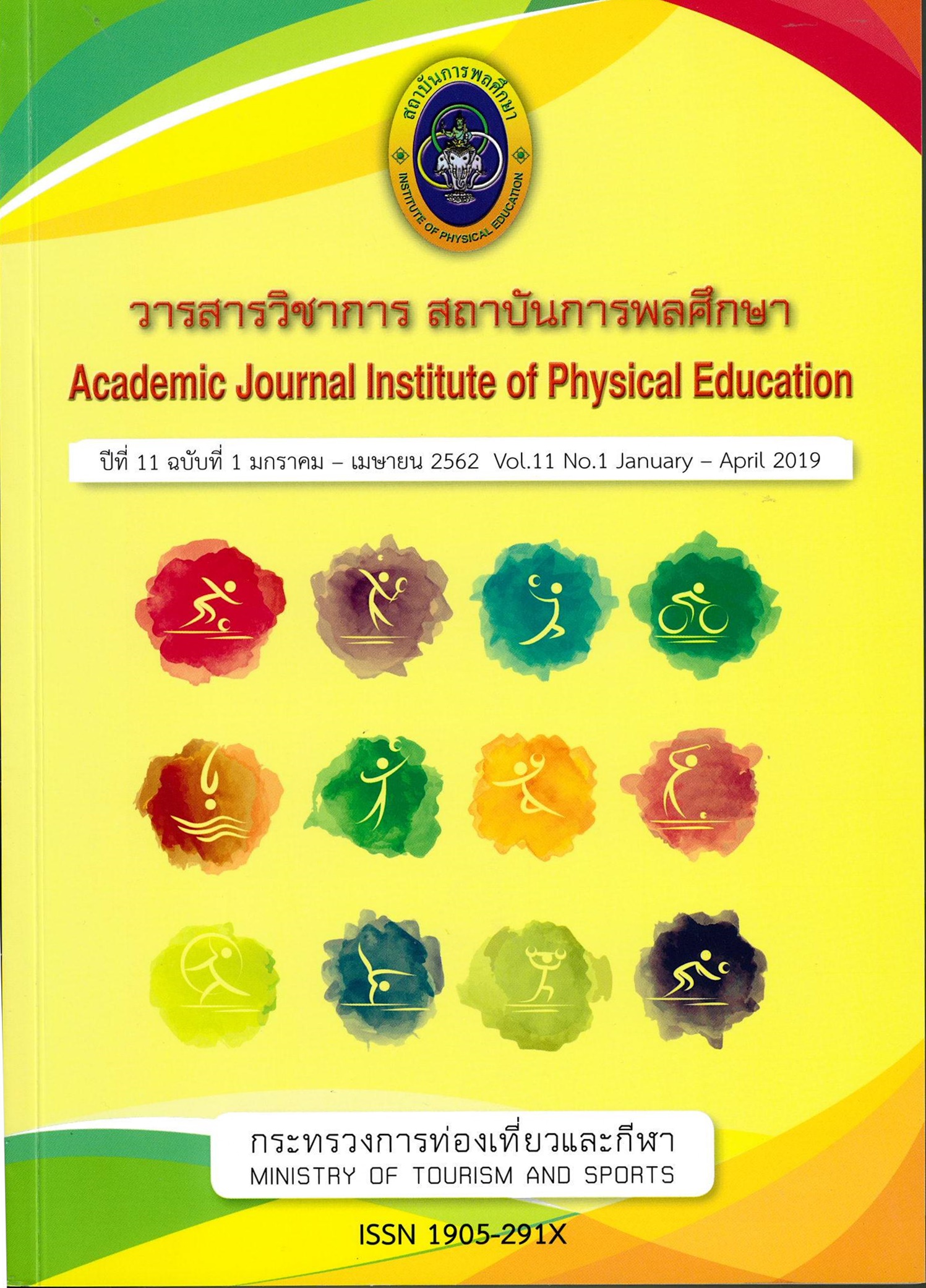A COMPARISON BETWEEN THE EFFECTS OF FOAM ROLLING AND ACTIVE RECOVERY ON FORCE RECOVERY AND BLOOD LACTATE CONCENTRATION IN FUTSAL PLAYERS
Main Article Content
Abstract
The purposes of the study were to compare between the effects of foam rolling and active recovery on force recovery and blood lactate concentration in futsal players. The subjects were seventeen male futsal players of Chulalongkorn University, aged between 18-24 years old in 2016 academic year. All subjects participated in a fatigue program by using isokinetic dynamometer, then attended experiments in two methods of 8 minutes recovery which were using foam rolling and active recovery by spacing between each recovery method at least one week. Blood lactate concentration level and peak torque were measured at rest before participating the fatigue program, before experiment, immediately after experiment and 12 minutes after experiment. The obtained data were analysed by calculating mean and standard deviation. The paired t-test was used for a within group comparison, independent t-test for a between group comparison. One-way ANOVA with repeated measures also used to determine the significant differences of blood lactate concentration level and peak torque at rest before participating the fatigue program, before experiment, immediately after experiment and 12 minutes after experiment.
The results were as follows: There was difference at the significance level of 0.05 between the means of peak torque and blood lactate concentration level in foam rolling group and active recovery group by comparing in the same group before experiment and immediately after experiment. There was no difference between the means of peak torque and blood lactate concentration level in foam rolling group and active recovery group by group comparison immediately after experiment. The study showed that using foam rolling and active recovery did improve force recovery because the mean of peak torque increased. These methods also could decrease blood lactate concentration level.
Article Details
The published article is a copyright of the Academic Journal of Thailand National Sports University. The passage appeared in each article in this academic journal is a perspective of each author which is not related to the journal. Each author is required to be responsible for all components of his/her own article. If there are any mistakes, each author must be responsible for those mistakes on his/her own.
References
กรมพลศึกษา. (2555). คู่มือผู้ฝึกสอนกีฬาฟุตซอล T-Certificate: Futsal Referee Guide. กรุงเทพมหานคร: โรงพิมพ์องค์การสงเคราะห์ทหารผ่านศึก ในพระบรมราชูปถัมภ์.
กรมพลศึกษา. (2558). ลักษณะของสัดส่วนร่างกายและสมรรถภาพทางกลไกของนักกีฬาฟุตซอลระดับเยาวชนไทย. พิมพ์ครั้งที่ 1 กรุงเทพมหานคร: โรงพิมพ์วีรวรรณ พริ้นติ้งค์ แอนด์ แพ็คเก็จจิ้ง.
ณัฐชนนท์ ซังพุก, บุญส่ง โกสะ, ถนอมวงศ์ กฤษณ์เพ็ชร์ และณัฐยา แก้วมุกดา. (2559). ผลของรูปแบบการฟื้นสภาพภายหลังการออกกำลังกาบที่มีต่อระดับความเข้มข้นของกรดแลคติกและอัตราการเต้นของหัวใจในนักกีฬาฟุตบอล. วารสารวิชาการสถาบันการพลศึกษา, 8(2) 159-174.
ถนอมวงศ์ กฤษณ์เพ็ชร์ และสิทธา พงษ์พิบูลย์. (2554). สรีรวิทยาการออกกำลังกาย. กรุงเทพมหานคร: ตีรณสาร.
รัชฎา แก่นสาร์ และคณะ. (2557). สรีรวิทยา 1. พิมพ์ครั้งที่ 2 กรุงเทพมหานคร: ธนาเพรส.
American College of Sports Medicine. (2000). Guidelines for Exercise Testing and Training of the American College of Sports Medicine: Baltimore, MD: Williams & Wilkins.
Curran, P. F., Fiore, R. D. and Crisco, J. J. (2008). A comparison of the pressure exerted on soft tissue by 2 myofascial rollers. Journal of sport rehabilitation, 17, 432.
de Moura, N. R., Cury-Boaventura, M. F., Santos, V. C., Levada-Pires, A. C., Bortolon, J., Fiamoncini, J., Pithon-Curi, T. C., Curi, R. and Hatanaka, E. (2012). Inflammatory response and neutrophil functions in players after a futsal match. The Journal of Strength & Conditioning Research, 26, 2507-2514.
Edmunds, R., Dettelbach, A., Dito, J., Kirkpatrick, A., Parra, A., Souder, J., Stevenson, T. and Astorino, T. A. (2016). Effects of foam rolling versus static stretching on recovery of quadriceps and hamstrings force. Journal of Bodywork and Movement Therapies, 20, 146.
Foss, Merle L, & Keteyian, Steven J. (1998). Fox's Physiological Basis for Exercise and Sport: William C. Brown.
MacDonald, G. Z., Penney, M. D., Mullaley, M. E., Cuconato, A. L., Drake, C. D., Behm, D. G. and Button, D. C. (2013). An acute bout of self-myofascial release increases range of motion without a subsequent decrease in muscle activation or force. The Journal of Strength & Conditioning Research, 27, 812-821.
McArdle, William D., Katch, Frank I., & Katch, Victor L. (2000). Essentials of exercise physiology / William D. McArdle, Frank I. Katch, Victor L. Katch: Philadelphia : Lippincott Williams & Wilkins, c2000.
Ramos-Campo, D., Rubio-Arias, J., Carrasco-Poyatos, M. and Alcaraz-Ramón, P. (2016). Physical performance of elite and subelite Spanish female futsal players. Biology of Sport, 33(3), 297-304.
Schroeder, A. N. and Best, T. M. (2015). Is self myofascial release an effective preexercise and recovery strategy? A literature review. Current sports medicine reports, 14, 200-208.
Vaeyens, R., Lenoir, M., Williams, A. M. and Philippaerts, R. M. (2007). Mechanisms underpinning successful decision making in skilled youth soccer players: An analysis of visual search behaviors. Journal of Motor Behavior, 39, 395-408.
Vigotsky, A. D., Lehman, G. J., Contreras, B., Beardsley, C., Chung, B. and Feser, E. H. (2015). Acute effects of anterior thigh foam rolling on hip angle, knee angle, and rectus femoris length in the modified Thomas test. Peer Journal, 3, 1281.
Woods,K., Bishop,P., and Jones,E. 2007. Warm-Up and Stretching in the Prevention of Muscular Injury. Sports Medicine. 37(12): 1089-1099


